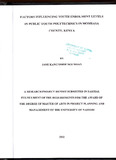Factors influencing youth enrolment levels in Public Youth Polytechnics in Mombasa County, Kenya

View/
Date
2012Author
Ngumbao, Jane Kang'ombe
Type
ThesisLanguage
en_USMetadata
Show full item recordAbstract
The study investigated the effect of economic status, socio-cultural factors, historical factors, quality of education and Youth Polytechnic administration structures on youth enrolment levels in Public Youth Polytechnics in Mombasa County, Kenya. The ability to cater for the cost of education denoted economic status, socio-cultural factors revolved around issues of gender and class structures, people's perception towards vocational training was assumed to emanate from historical factors, availability of training inputs, outputs and outcomes represented quality of education and administration structures were assumed to enhance effectiveness and efficiency in Youth Polytechnics.
The study particularly sought to identify and give suggestions that could help assist Public Youth Polytechnics in Mombasa County to improve their enrolment levels. The study was considered due to the fact that the Youth Polytechnics absorption capacity of Primary School leavers has continued to be low despite the increase in the number of schoolleavers who do not make it to Secondary School and the minimal impact that Government programs to rehabilitate Youth Polytechnic have had on enrolment levels. The study was conducted through descriptive survey research design.
Data was collected using questionnaires from 349 youth, 205 yp trainees and 15 instructors. The youth were selected from a target population of 4826 youth who are members of various youth bunges in Mombasa County through the use of Cluster sampling technique while all trainees and instructors in Public Youth Polytechnics within Mombasa County were included in the study.
The data was analyzed using Frequencies, Percentages and the Chi-square test statistic and presented in tables. The study established that gender based socio-cultural factors, socio-cultural backgrounds, family's ability to pay school fees, availability of physical infrastructure, and value of the educational certificate have a significant influence on youth enrolment levels.
The study concludes that economic status, socio-cultural factors and quality of education are factors influencing youth enrolment levels in Public YPs in Mombasa County. It recommends the formulation of regulations to ensure yP fees are affordable to the target population, introduction of more gender oriented courses, intensification of sensitization programmes on the value of yP education and the integration of vocational training into the mainstream education system. The researcher suggests that a similar research with a much wider focus and an independent research on the effect that a central governing body would have on youth enrolment levels in YPs be done.
Publisher
University of Nairobi, Kenya
